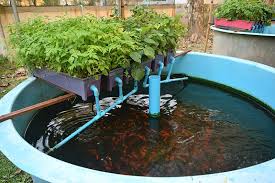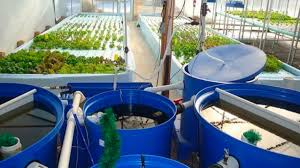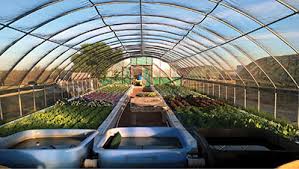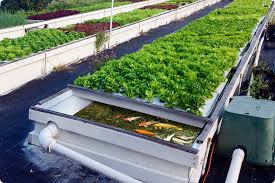The Benefits of Aquaponics are attracting increased attention as people search for sustainable and efficient ways to produce food. Aquaponics is an innovative, eco-friendly agricultural system that combines aquaculture (raising fish) with hydroponics (growing plants in water). This symbiotic setup allows fish and plants to support each other, creating a self-sustaining ecosystem.
In aquaponics, fish waste provides essential nutrients for plants, and the plants, in turn, filter and clean the water for the fish. The system recycles water continuously, drastically reducing water usage compared to traditional soil-based agriculture. Additionally, it eliminates the need for chemical fertilizers and pesticides, making it both environmentally friendly and safe for consumers.
One of the main benefits of aquaponics is its water efficiency. Traditional farming can be very water-intensive, but aquaponics uses about 90% less water, making it an ideal solution in regions facing water scarcity. Since the water is recirculated in a closed-loop system, it’s not wasted; instead, it nourishes plants and then returns to the fish tanks, purified. This approach conserves resources while allowing for a high-yield crop production.
Aquaponics also offers a sustainable way to produce food without relying on synthetic chemicals. In soil-based farming, farmers often use chemical fertilizers to boost plant growth. However, in aquaponics, the fish naturally produce the necessary nutrients, such as ammonia, which bacteria convert into nitrites and then into nitrates that plants can absorb.
By using a natural cycle, aquaponics eliminates the need for chemical additives and reduces pollution, producing fresh, organic food.
Another significant benefit is the space efficiency of aquaponics. This system can be set up indoors, in greenhouses, or even in urban environments, allowing fresh food to be produced close to where it’s consumed. Since plants don’t require soil, they can be grown vertically, maximizing space.
This setup allows individuals and communities with limited land to grow their own food, making it possible to cultivate vegetables and herbs in places like rooftops or small yards. Additionally, aquaponics can provide year-round food production, unlike traditional farming that depends on seasonal changes.
The benefits of aquaponics extend beyond environmental factors; it also has positive social and economic impacts. Since aquaponics systems can be scaled to fit different sizes, they are accessible to hobbyists, commercial growers, and educational institutions alike. Schools, for example, use aquaponics systems to teach students about biology, ecology, and sustainable agriculture.
In underserved areas, aquaponics can provide a reliable source of fresh produce, improving food security and supporting local economies by reducing the need for food transportation.
How Aquaponics Works
Aquaponics systems work by circulating water from a fish tank to plant grow beds. Beneficial bacteria convert fish waste (ammonia) into nitrates, a form of nitrogen that plants can absorb.
The plants filter the water, removing harmful substances, and the clean water is recirculated back into the fish tank. This closed-loop system ensures a balanced ecosystem, benefiting both plants and fish.
Environmental Benefits of Aquaponics
Aquaponics offers numerous environmental advantages:
1. Reduced Land Use: Aquaponics systems require significantly less land than conventional farming, making it ideal for urban settings.
2. No Soil Degradation: Since plants are grown in water, aquaponics eliminates soil erosion, nutrient depletion, and the need for chemical fertilizers.
3. Lower Carbon Footprint: By growing food locally and reducing transportation needs, aquaponics helps reduce greenhouse gas emissions associated with long-distance food supply chains.
Water Conservation in Aquaponics Systems

Water conservation is a standout benefit of aquaponics:
1. Closed-Loop System: Unlike traditional agriculture, which can waste significant amounts of water through runoff and evaporation, aquaponics recirculates water within the system, drastically reducing water consumption.
2. Minimal Water Loss: The only water lost in aquaponics systems comes from evaporation or plant uptake, making it up to 90% more water-efficient than soil-based agriculture.
3. Sustainable Use of Water Resources: Aquaponics offers a solution for growing food in areas with limited water availability, helping conserve vital freshwater resources.
Energy Efficiency and Resource Savings
Aquaponics is known for its energy and resource efficiency:
1. Reduced Input Requirements: The natural nutrient cycling between fish and plants reduces the need for synthetic fertilizers and pesticides, cutting down on input costs and environmental impact.
2. Energy Savings: Vertical and indoor aquaponics systems can be optimized with energy-efficient technologies, such as LED lighting and solar power, to minimize the use of non-renewable energy sources.
3. Waste Reduction: Fish waste and organic matter are repurposed as plant nutrients, reducing overall waste and promoting resource circularity.
Sustainable Food Production
Aquaponics is a model for sustainable food production:
1. Organic Growth: Since aquaponics systems do not rely on synthetic chemicals, they can produce organic crops and fish, promoting healthier, natural food production.
2. Year-Round Farming: Aquaponics systems can be operated year-round, regardless of climate conditions, ensuring a consistent food supply even in regions with extreme weather.
3. Local Food Systems: By enabling food production close to urban areas, aquaponics reduces the environmental and economic costs associated with long-distance food transportation.
Read Also: All You Need To Know About Soft Grass
Economic Advantages of Aquaponics

Aquaponics offers several economic benefits that make it an attractive option for sustainable farming. These include:
1. Reduced Input Costs: Aquaponics systems require fewer inputs like chemical fertilizers and pesticides, as the waste produced by the fish provides natural nutrients for the plants. This reduces the costs associated with traditional farming.
2. Efficient Use of Resources: The closed-loop system conserves water and maximizes land use, allowing farmers to grow more food in smaller spaces, which can lead to higher profitability, especially in urban areas where land is expensive.
3. Year-Round Production: Aquaponics allows for continuous farming regardless of seasons, which means a steady supply of produce and fish throughout the year. This consistent production translates to reliable income for farmers.
4. Market Value for Organic Produce: Aquaponics-grown crops and fish are often organic, pesticide-free, and non-GMO, which can command higher prices in the market. Consumers are increasingly willing to pay a premium for healthy, locally grown, and environmentally friendly products.
Improved Plant Growth and Crop Yield
The synergy between fish and plants in an aquaponics system promotes enhanced plant growth and higher crop yields due to:
1. Nutrient-Rich Water: Fish waste provides plants with a steady supply of nutrients, particularly nitrogen, phosphorus, and potassium, which are essential for healthy plant growth. This natural fertilization leads to faster and more robust crop development.
2. Controlled Growing Conditions: Aquaponics systems are typically set up indoors or in greenhouses, where factors like temperature, humidity, and light can be carefully regulated. This allows for optimal growing conditions, resulting in improved yields compared to outdoor farming.
3. Faster Growth Cycles: Plants grown in aquaponics systems often mature faster than those in soil due to the constant availability of water and nutrients, leading to quicker harvests and more frequent planting cycles.
Fish and Plant Synergy in Aquaponics
The symbiotic relationship between fish and plants in aquaponics is the foundation of its success:
1. Fish as Nutrient Providers: Fish produce waste that is broken down into nitrate by beneficial bacteria. This nitrate serves as a natural fertilizer for the plants, providing the essential nutrients they need to grow.
2. Plants as Water Purifiers: In turn, plants filter and clean the water by absorbing these nutrients, helping to maintain a healthy environment for the fish. This natural filtration reduces the need for chemical treatments or external filtration systems.
3. Balanced Ecosystem: The mutually beneficial relationship between fish and plants creates a balanced ecosystem, which minimizes waste and maximizes efficiency. This system ensures that both components thrive, making aquaponics an ideal model for sustainable agriculture.
Health and Nutritional Benefits of Aquaponics
Aquaponics offers several health and nutritional advantages:
1. Fresh and Organic Produce: Aquaponics systems produce pesticide-free, non-GMO fruits, vegetables, and herbs. The freshness and natural growth methods enhance the nutritional content, providing healthier food options for consumers.
2. High-Quality Protein Source: The fish raised in aquaponics systems offer a valuable source of protein. Since these fish are raised in a clean and controlled environment, they are free from antibiotics and hormones often found in commercially farmed fish.
3. Nutrient-Dense Foods: The plants grown in aquaponics systems often contain higher levels of essential vitamins and minerals because they are fed a continuous supply of nutrients from the fish waste. This leads to nutrient-rich produce that contributes to a healthier diet.
Read Also: 22 Medicinal Health Benefits of Nutmeg (Myristica Fragrans)
Aquaponics in Urban Farming

Aquaponics is an ideal solution for urban farming, where space is limited and access to fresh food can be challenging:
1. Vertical and Space-Efficient Systems: Aquaponics systems can be designed to fit small spaces, including rooftops, basements, and backyards. Vertical farming setups allow for the growth of multiple layers of plants, maximizing space in urban environments.
2. Local Food Production: Urban aquaponics farms reduce the need for long-distance transportation of food, leading to fresher produce for city dwellers and reduced carbon emissions from food transport.
3. Community Engagement: Urban aquaponics projects can serve as educational tools, teaching local communities about sustainable farming practices and providing fresh food to areas that may lack access to nutritious options.
4. Business Opportunities: With the growing demand for locally grown, sustainable food, urban aquaponics farms present entrepreneurial opportunities for individuals and businesses looking to supply fresh produce and fish to local markets, restaurants, and consumers.
Aquaponics combines economic, environmental, and health benefits, making it a powerful tool for sustainable food production, particularly in urban environments where space and resources are limited. Its potential to provide fresh, healthy food year-round positions it as a key player in the future of agriculture.
Do you have any questions, suggestions, or contributions? If so, please feel free to use the comment box below to share your thoughts. We also encourage you to kindly share this information with others who might benefit from it. Since we can’t reach everyone at once, we truly appreciate your help in spreading the word. Thank you so much for your support and for sharing!
Read Also: A Comprehensive Guide To Circular Economy Consulting






